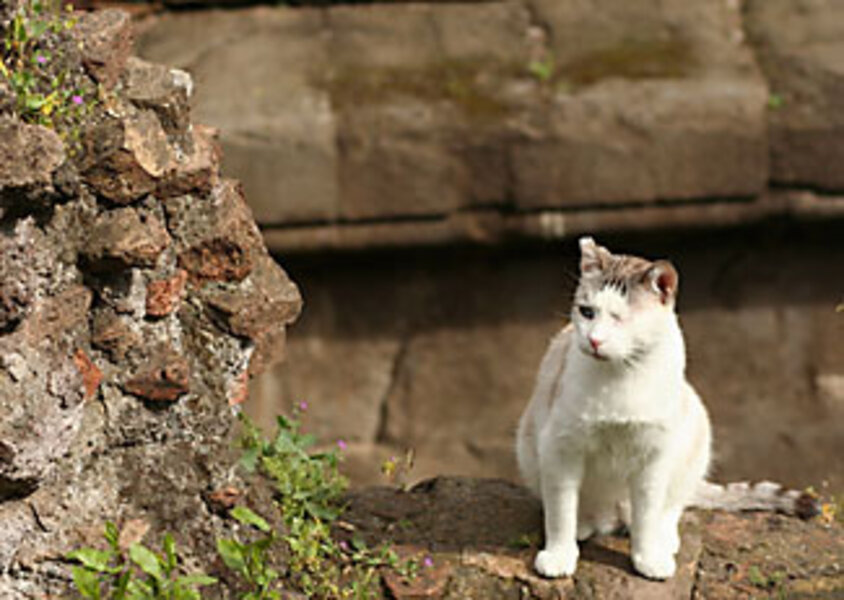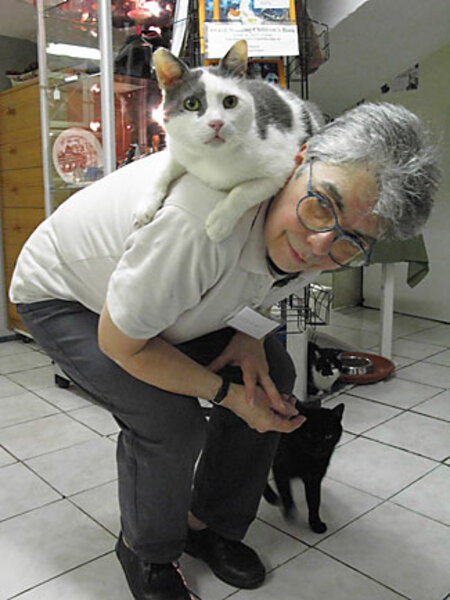Cats among the ruins
Loading...
| Rome
Gazing into a huge, rectangular hole that contains four Roman temples, I'm searching for Nelson, the one-eyed king. I walk along the metal fence surrounding the archaeological dig, which is about the size of a soccer field. Somewhere among the crumbling stones 16 feet below street level, I hope to find the feline modern-day "ruler" of these ancient ruins.
Only a five-minute walk from the Pantheon, Area Sacra di Largo Argentina (an ancient Roman Square) rests at the heart of the Eternal City. Behind me, pedestrians bustle, vehicles rev, and mopeds blare. However, below me sprawls a world untrampled by humans. Wild grass grows under Italian umbrella pines, highlighting the travertine brick pavements. Stone steps ascend to the temples' roofless, pillared porticoes. Among them, a colony of cats is resting or playing in the sun.
My search for the felines began after seeing some calendars and postcards of Roman cats posing at the Coliseum, lounging near the colossal marble foot of Constantine, and napping atop a fallen Corinthian capital.
When Egypt became part of the Roman Empire, the cult of cat-headed goddess Bastet crossed the Mediterranean. Its worship became so popular, overshadowing the reverence of the emperor, that eventually an imperial decree banned all cats.
But some survived. The idea that a few of the descendants still live within the imperial ruins aroused my curiosity.
Thus I ended up at the largest cat colony in Rome, the Torre Argentina cat sanctuary, and to the story of Nelson.
At one corner of the ruins, I spot a one-eyed cat. He's perched on an old Roman wall. Near him, metal stairs lead down onto a small courtyard. A few cats saunter in the shade of blooming vines. The sanctuary occupies a cave, an excavated section of a temple buried under the bustling Via Florida.
Inside, Daniele Petrucci, an assistant veterinarian, tells me that the one-eyed cat I saw is not Nelson. "We have many one-eyed cats," he says. He shows me a children's book, "Nelson the One-Eyed King." On the back cover is a photograph of a white, long-haired, one-eyed cat that may have had a hint of Persian blood. Nelson died in November 2000. Today, about 250 cats call his kingdom their home.
About 14 years ago, Lia Dequel, a retired cruise-ship boutique director, and Silvia Viviani, a retired opera singer, started helping the abandoned cats. Over time, their acts of kindness grew into a nonprofit organization. Now, they work full time, supported by donations and volunteers.
Helpers who live in Rome handle the administration, conduct free guided tours of the ruins, and care for sick or injured cats. Other volunteers come from all over the world, some for a few days, some for weeks. They help with whatever needs doing around the no-kill facility and assist visitors.
New cats arrive at the sanctuary almost daily. Each is given a name, then photographed, registered, medically treated if needed, vaccinated, and spayed or neutered. If it has a right demeanor, it's put up for adoption.
Additionally, the sanctuary supports 40 other smaller cat colonies in Rome with food and medical needs.
But this main colony may have to move. "We are considered squatters," explains Ms. Dequel, as she prepares a shelter for a sick male cat just brought in. She hangs a plate with the cat's name, Zanche, on the cage. Then she drapes a thick cloth over the top because the cave turns cold and damp at night. "The city has plans to excavate the temple," she says, "and we're in the way."
A visitor drops by. Miesa Myrick, a flight attendant, hands Dequel an envelope.
A year ago, Ms. Myrick was on a layover in Rome. Not knowing anything about the sanctuary, she walked by Torre Argentina. "I saw a little tiger kitty playing on the stairs of a ruin," she says. "It had only one eye."
She adopted the kitten, Durer, and flew him back to her home in Maryland. Wanting to do more, she hosted a toga party. Guests came dressed in Roman garb and were shown videos and photographs of the rescued cats. The envelope she gave Dequel contains their donations.
I think that Nelson would be pleased so many people care. He, too, was an abandoned cat.
"It all happened 13 years ago," says Deborah D'Alessandro, author of the book "Nelson the One-Eyed King." "A big white cat arrived, its eye dislodged, shot by a kid with a BB gun." His imposing size and gentleness earned him a name derived from Lord Nelson, the famous English admiral.
Soon, as he perched on the Roman wall, his furry mane fluffed over his large body, he attracted the locals. Tourists, too, paused to pay homage. "People would come, calling out his name," Ms. D'Alessandro says, "with gifts of gourmet cat foods."
Nelson reigned for five years, but then became ill. A German family adopted him, so that he lived his last eight months surrounded by love.
Forgotten among the ruins, a white marble slab marks the spot where Julius Caesar was assassinated. In time, this obscure marker may well be lost to memory. However, having been touched by the kind-hearted people who carry on in Nelson's feline kingdom, most visitors to Torre Argentina leave impressed by an experience they'll long remember.






